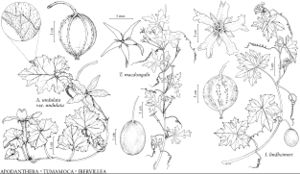Tumamoca macdougalii
Contr. U.S. Natl. Herb. 16: 21, plate 17 [as macdouglai]. 1912.
Stems: persistent woody portion 10–15 cm. Leaf-blades 3–4.5 cm, ultimate segments linear to linearlanceolate or narrowly ovate, 2–4 cm × 2–10 mm, surfaces hispidulous to pustulate-scabrous abaxially, glabrous adaxially. Inflorescences: staminate 2–19-flowered, 3.5–10 cm. Flowers: staminate: hypanthium 5–9 mm, petals 4–4.5 mm; pistillate: petals 5–6 mm. Fruits 0.8–1 cm diam. Seeds 7–8 mm.
Phenology: Flowering Jun–Oct.
Habitat: Semidesert grasslands, sandy washes and gullies, Atriplex flats, Sonoran desert scrub with Agave, Atriplex, Cercidium, Fouquieria, Jatropha, Lycium, Maytenus, Opuntia, Prosopis, and Stenocereus
Elevation: 700–1000 m
Distribution

Ariz., Mexico (Sonora)
Discussion
In Tumamoca macdougalii, some plants produce all pistillate flowers, some all staminate flowers (dioecy), and some produce both pistillate and staminate (monoecy). Most plants apparently start the early summer as all staminate but only buds are produced, thus the staminate flowers quickly respond if rains come early. Pistillate flowers are not produced until the rains come in season, and then plants may be bisexual. The size of the tuber and the age of the plant may modify this schedule. Smaller plants may not produce pistillate flowers; larger plants may produce all pistillate flowers. (Biological information from Frank Reichenbacher, pers. comm.).
Selected References
None.
